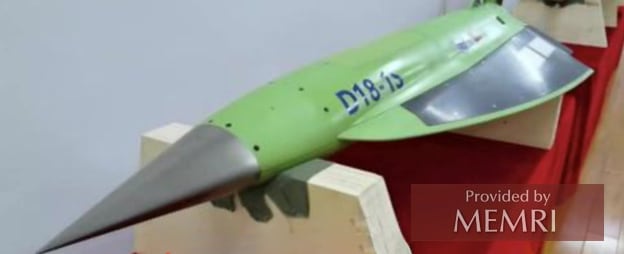An article on China's Sina Military website, published November 24, 2020 and titled "The Chinese Version of 'The Rods From God'? CCTV Unveils Three Hypersonic Vehicles Capable of a Wide Speed Range."[1] The article, attributed to "Bai Zhan Dao," describes China's 2018 test launch of hypersonic vehicles from airships. It predicts that hypersonic weapons launched in this fashion may be the next generation of weapons capable of penetrating enemy air defenses, and compares it to the U.S. Air Force's Cold War-era "Rods from God" concept weapon.
Below is the text of the article:
"Recently, [the official CCP outlet] CCTV reviewed China's first near-space test launch of hypersonic vehicles capable of a wide speed range, which took place on September 21, 2018. It showed three scale models of the hypersonic vehicles used in the test – namely, the D18-1S, D18-2S and D18-3S vehicles.
"In the 2018 test at the Jiuquan Satellite Launch Center, three scaled-down models were lifted aloft by an air balloon, were dropped, entered free flight, accelerated past the speed of sound, entered an aerodynamic bounce state, and finally deployed parachutes and landed for recovery. The unique launch test has caught the imagination of many netizens, who believe it heralds the imminent arrival of the ultimate weapon: the 'Rods from God.'
The so-called 'Rods from God' are a space-based kinetic energy weapon concept from America's 'Star Wars' project during the Cold War. It consists of telephone-pole-sized tungsten rods that are launched at ground targets from satellites and that reach a maximum speed of Mach 10 before striking their targets. The kinetic energy of the rods would be equivalent to 11.5 tons of TNT, making them like a tactical nuclear weapon without causing any radiation contamination.

Mil.sina.cn/zm/2020-11-24/detail-iiznezxs3400422.d.html, November 24, 2020.

Mil.sina.cn/zm/2020-11-24/detail-iiznezxs3400422.d.html, November 24, 2020.
"Due to the extremely high speed and small radar cross-section of the tungsten rods, the weapon is theoretically extremely difficult to defend against. However, the difficulties in researching and developing precision guidance technology, as well as the high cost of positioning tungsten rod ammunition in orbit, prevented the American 'Rods from God' concept from ever becoming practical.
"The hypersonic vehicles tested by China in 2018 have nothing to do with the 'Rods from God' and are only free-flight models used to verify the aerodynamic layout of hypersonic weapons. However, they resemble the "Rods from God" in terms of how they were delivered.
"The large amount of flight data obtained from the test will contribute to the development of China's second-generation hypersonic vehicles. Clearly, hypersonic weapons are superior tactically and cost-wise to the 'Rods from God,' and there is no concern that they would be targeted by anti-satellite weapons.
"The 'wide speed range' of these hypersonic vehicles means that the aerodynamic layout of the vehicles can adapt to the hypersonic wave-riding flight at speeds above Mach 6 after reentry into the atmosphere. At the same time, after slowing down to lower speeds, it enables the vehicles to maneuver towards their targets and to avoid being attacked, improving the weapon's ability to penetrate air defenses and accurately strike its targets.
"To achieve this goal, the D18-1S and D18-3S were designed using a conventional wave-rider aerodynamic layout. The difference between the two models is that the D18-1S has a single vertical tail and the D18-3S has a double vertical tail.
"The D18-2S has a parafoil aerodynamic layout, meaning that its entire fuselage is suspended below the wings. This design is very rare in hypersonic vehicles, and it may have greater advantages when it comes to the distribution of internal loads.
"Regardless of the layout, the high lift-to-drag ratio of various hypersonic vehicles with a wide speed range would increase the range and maneuverability of hypersonic weapons, allowing them to easily penetrate any existing anti-missile defense system.
"Research on hypersonic vehicles with a wide speed range will also contribute to the development of a Chinese aerospace plane or supersonic passenger plane.
"The fact that the D18-1S, D18-2S, and D18-3S models have been revealed to the public naturally shows that our country already has even more advanced designs. Showing off failed designs now isn't harmful; it can actually cheer people up."
[1] Mil.sina.cn/zm/2020-11-24/detail-iiznezxs3400422.d.html, November 24, 2020.








